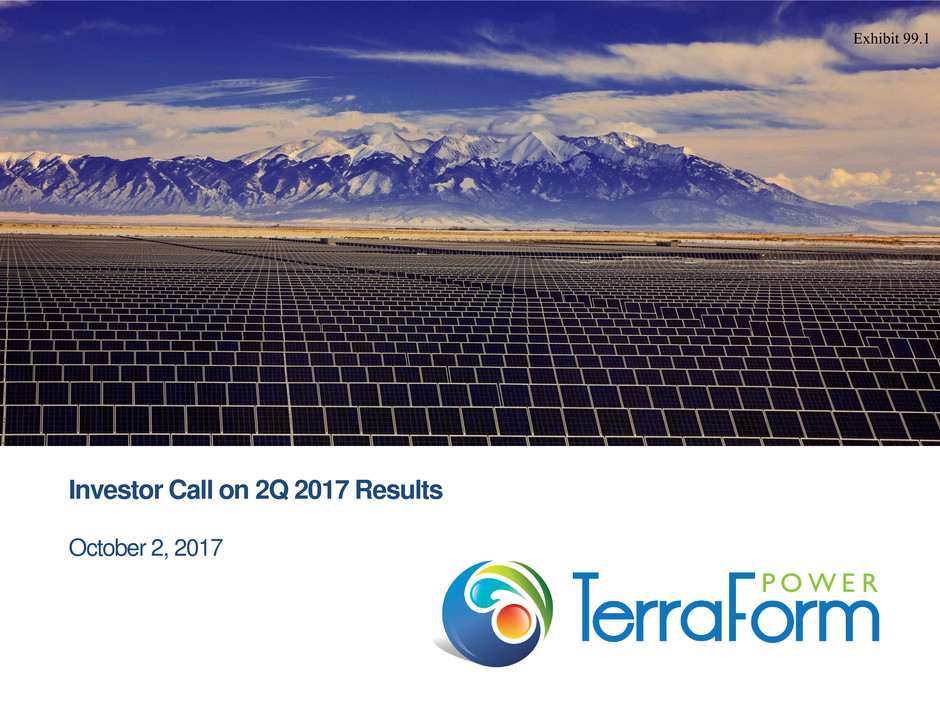
Investor Call on 2Q 2017 Results October 2, 2017 Exhibit 99.1

2 This communication contains forward-looking statements within the meaning of Section 27A of the Securities Act of 1933 and Section 21E of the Securities Exchange Act of 1934. Forward-looking statements can be identified by the fact that they do not relate strictly to historical or current facts. These statements involve estimates, expectations, projections, goals, assumptions, known and unknown risks, and uncertainties and typically include words or variations of words such as “expect,” “anticipate,” “believe,” “intend,” “plan,” “seek,” “estimate,” “predict,” “project,” “goal,” “guidance,” “outlook,” “objective,” “forecast,” “target,” “potential,” “continue,” “would,” “will,” “should,” “could,” or “may” or other comparable terms and phrases. All statements that address operating performance, events, or developments that TerraForm Power expects or anticipates will occur in the future are forward-looking statements. They may include estimates of expected adjusted EBITDA, cash available for distribution (CAFD), earnings, revenues, income, loss, adjusted revenues, capital expenditures, liquidity, capital structure, future growth, and other financial performance items (including future dividends per share), descriptions of management’s plans or objectives for future operations, products, or services, or descriptions of assumptions underlying any of the above. Forward-looking statements provide TerraForm Power’s current expectations or predictions of future conditions, events, or results and speak only as of the date they are made. Although TerraForm Power believes its expectations and assumptions are reasonable, it can give no assurance that these expectations and assumptions will prove to have been correct and actual results may vary materially. By their nature, forward-looking statements are subject to risks and uncertainties that could cause actual results to differ materially from those suggested by the forward-looking statements. Factors that might cause such differences include, but are not limited to, risks related the previously announced sponsorship transaction with Brookfield Asset Management Inc. and its affiliates (the “Sponsorship Transaction”), including the expected timing and likelihood of completion of the Sponsorship Transaction, the timing, receipt and terms and conditions of any required governmental approvals of the Sponsorship Transaction that could cause the parties to abandon the transaction; the occurrence of any event, change or other circumstances that could give rise to the termination of the merger agreement relating to the Sponsorship Transaction; the risk of failure of the holders of a majority of the outstanding Shares to adopt the merger agreement and other agreements contemplated by the Sponsorship Transaction and to obtain the requisite stockholder approvals; the risk that the parties may not be able to satisfy the conditions to the Sponsorship Transaction in a timely manner or at all; risks related to cash trapped at the project level, including the risk that such project-level cash may not be released up to the Company in a timely manner; risks related to the proposed relocation of the Company’s headquarters, which the Company expects will result in significant turnover in its current workforce and the loss of employees with institutional knowledge of our business; risks related to disruption of management time from ongoing business operations due to the Sponsorship Transaction; the risk that any announcements relating to the Sponsorship Transaction or the failure or termination of the Sponsorship Transaction could have adverse effects on the market price of the Company’s common stock; the risk that the Sponsorship Transaction and its announcement could have an adverse effect on the Company’s ability to retain and hire key personnel and maintain relationships with its suppliers and customers and on its operating results and businesses generally, risks related to the SunEdison bankruptcy, including our transition away from reliance on SunEdison for management, corporate and accounting services, employees, critical systems and information technology infrastructure, and the operation, maintenance and asset management of our renewable energy facilities; risks related to events of default and potential events of default arising under our revolving credit facility, the indentures governing our senior notes, and/or project-level financing; risks related to failure to satisfy the requirements of Nasdaq, which could result in the delisting of our common stock; risks related to delays in our filing of periodic reports with the SEC; pending and future litigation; our ability to integrate the projects we acquire from third parties or otherwise realize the anticipated benefits from such acquisitions; the willingness and ability of counterparties to fulfill their obligations under offtake agreements; price fluctuations, termination provisions and buyout provisions in offtake agreements; our ability to successfully identify, evaluate, and consummate acquisitions; government regulation, including compliance with regulatory and permit requirements and changes in market rules, rates, tariffs, environmental laws and policies affecting renewable energy; operating and financial restrictions under agreements governing indebtedness; the condition of the debt and equity capital markets and our ability to borrow additional funds and access capital markets, as well as our substantial indebtedness and the possibility that we may incur additional indebtedness going forward; our ability to compete against traditional and renewable energy companies; potential conflicts of interests or distraction due to the fact that several of our directors and most of our executive officers are also directors or executive officers of TerraForm Global, Inc.; and hazards customary to the power production industry and power generation operations, such as unusual weather conditions and outages. Furthermore, any dividends that we may pay in the future will be subject to available capital, market conditions, and compliance with associated laws and regulations. Many of these factors are beyond TerraForm Power’s control. TerraForm Power disclaims any obligation to publicly update or revise any forward-looking statement to reflect changes in underlying assumptions, factors, or expectations, new information, data, or methods, future events, or other changes, except as required by law. The foregoing list of factors that might cause results to differ materially from those contemplated in the forward-looking statements should be considered in connection with information regarding risks and uncertainties which are described in TerraForm Power’s Form 10-K for the fiscal year ended December 31, 2016, as well as additional factors it may describe from time to time in other filings with the Securities and Exchange Commission. You should understand that it is not possible to predict or identify all such factors and, consequently, you should not consider any such list to be a complete set of all potential risks or uncertainties. Forward-Looking Statements Exhibit 99.1

3 This presentation provides certain financial and operating metrics of TerraForm Power, Inc. (“TerraForm Power” or the “Company”) as of or for the quarters ended June 30, 2016 and June 30, 2017 and estimates for certain financial and operating metrics and measures of TerraForm Power for 2017. Please review these results together with the risk factors detailed in our annual report on Form 10-K for the fiscal year ended December 31, 2016 filed with the SEC on July 21, 2017. The full year 2017 financial information, estimates and operating metrics and measures included in this presentation are preliminary and unaudited and are forward looking and include estimates and forecasts for the remainder of the year which are inherently uncertain. This financial information may change materially as a result of the completion of the audit for fiscal year 2017 and our performance for the balance of 2017. Our estimates are based on various assumptions and are subject to various risks which could cause actual results to differ materially. The information presented on the following slides does not represent a complete picture of the financial position, results of operation or cash flows of TerraForm Power, is not a replacement for full financial statements prepared in accordance with U.S. GAAP and should not be viewed as indicative of future results, which may differ materially. You should also refer to our Form 10-K for the fiscal year 2016 and the other filings we have made with the SEC. Importance of our Risk Factors Exhibit 99.1
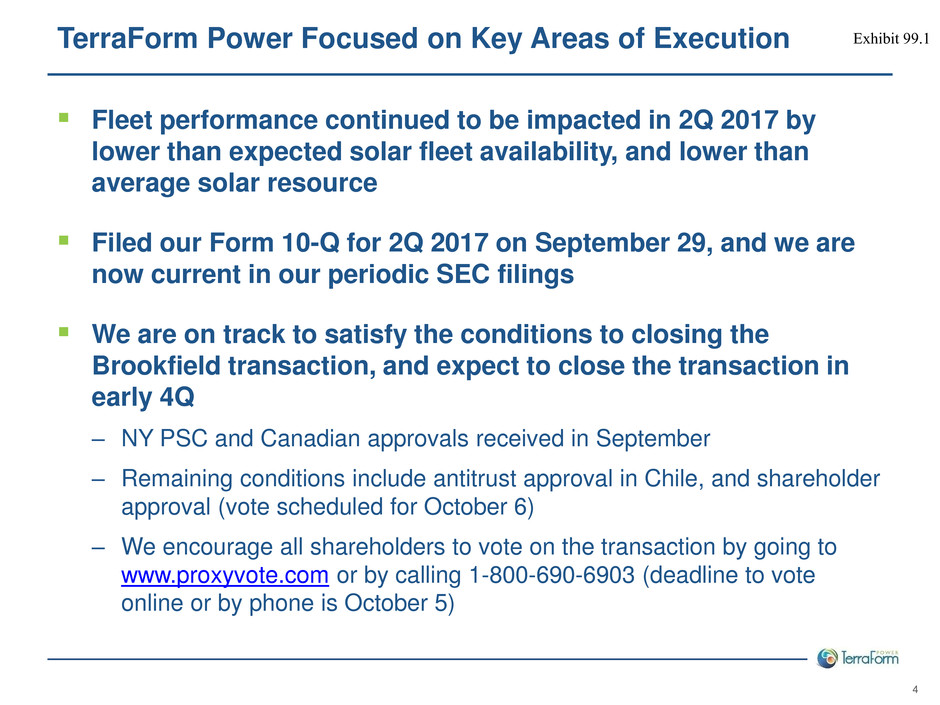
4 TerraForm Power Focused on Key Areas of Execution ▪ Fleet performance continued to be impacted in 2Q 2017 by lower than expected solar fleet availability, and lower than average solar resource ▪ Filed our Form 10-Q for 2Q 2017 on September 29, and we are now current in our periodic SEC filings ▪ We are on track to satisfy the conditions to closing the Brookfield transaction, and expect to close the transaction in early 4Q – NY PSC and Canadian approvals received in September – Remaining conditions include antitrust approval in Chile, and shareholder approval (vote scheduled for October 6) – We encourage all shareholders to vote on the transaction by going to www.proxyvote.com or by calling 1-800-690-6903 (deadline to vote online or by phone is October 5) Exhibit 99.1
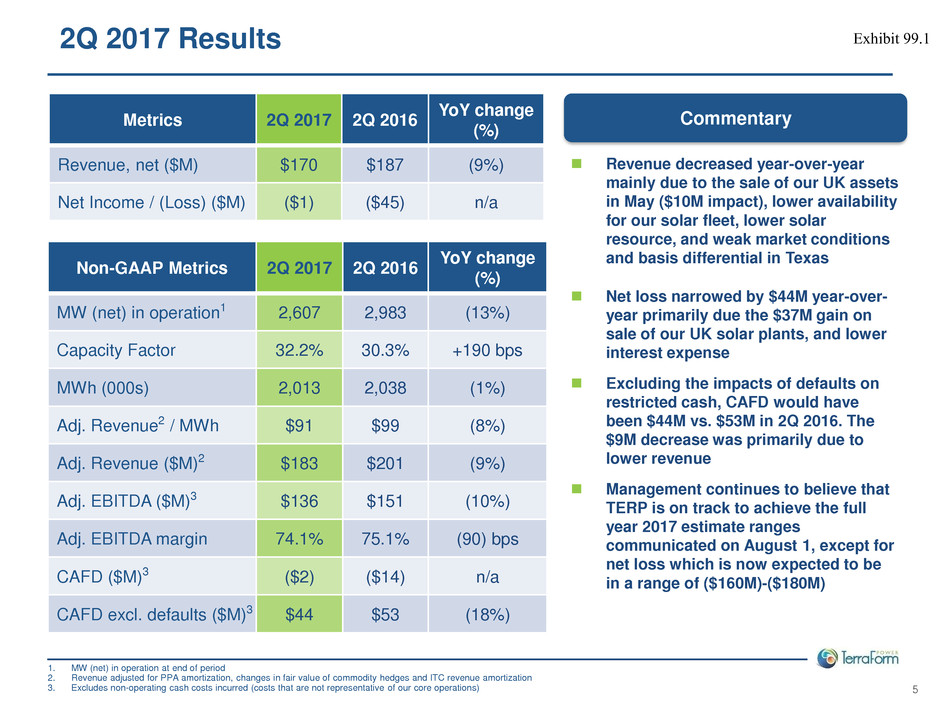
5 1. MW (net) in operation at end of period 2. Revenue adjusted for PPA amortization, changes in fair value of commodity hedges and ITC revenue amortization 3. Excludes non-operating cash costs incurred (costs that are not representative of our core operations) Non-GAAP Metrics 2Q 2017 2Q 2016 YoY change (%) MW (net) in operation1 2,607 2,983 (13%) Capacity Factor 32.2% 30.3% +190 bps MWh (000s) 2,013 2,038 (1%) Adj. Revenue2 / MWh $91 $99 (8%) Adj. Revenue ($M)2 $183 $201 (9%) Adj. EBITDA ($M)3 $136 $151 (10%) Adj. EBITDA margin 74.1% 75.1% (90) bps CAFD ($M)3 ($2) ($14) n/a CAFD excl. defaults ($M)3 $44 $53 (18%) 2Q 2017 Results CommentaryMetrics 2Q 2017 2Q 2016 YoY change (%) Revenue, net ($M) $170 $187 (9%) Net Income / (Loss) ($M) ($1) ($45) n/a Revenue decreased year-over-year mainly due to the sale of our UK assets in May ($10M impact), lower availability for our solar fleet, lower solar resource, and weak market conditions and basis differential in Texas Net loss narrowed by $44M year-over- year primarily due the $37M gain on sale of our UK solar plants, and lower interest expense Excluding the impacts of defaults on restricted cash, CAFD would have been $44M vs. $53M in 2Q 2016. The $9M decrease was primarily due to lower revenue Management continues to believe that TERP is on track to achieve the full year 2017 estimate ranges communicated on August 1, except for net loss which is now expected to be in a range of ($160M)-($180M) Exhibit 99.1

6 Appendix Exhibit 99.1

7 $478 $638 $153 ($93) ($42) $211 $86 ($100) ($55) Starting Balance (Dec 31,2016) Project Distributions Corp. Operating Costs and Interest Corp. Non Operating Costs UK Sale Canada Financing Portfolio Term Loan Partial Repayment Revolver Partial Repayment Ending Balance (June 30, 2017) HoldCo Cash: December 31, 2016 to June 30, 2017 $M, unless otherwise noted 1. June 30, 2017 drawn revolver balance was $497M and outstanding LCs were $61M, resulting in available revolver of $12M Operating Financing and M&A Non- Operating 1 ▪ At the end of 2Q we had HoldCo cash of $638M, which has been or will be reduced by: – Further repayment our revolver (including $150M in July and $70M in September) – Further repayment of our non-recourse portfolio term loan (including $30M in September) – Payment of the special dividend and costs associated with the Brookfield transaction Exhibit 99.1

8 2.6 GW Wind and Solar Portfolio … Exclusively renewable assets Portfolio as of June 30, 2017 With Estimated Average 26 Year Remaining Useful Life … Average asset age of 4 years With High Credit-Quality Counterparties High quality average credit rating of A; 84% rated investment grade 1 Under Long-Term Contracts … Average remaining PPA life of 14 years 1. 11% not rated; 5% rated non-investment grade (MW Weighted) (MW Weighted)(MW Weighted) High-Quality Contracted Renewable Generation Portfolio Solar 41% Wind 59% <2 years 20% 2-5 years 55% >5 years 25% 20+ years 21% 16-20 years 19% 11-15 years 35% 6-10 years 14% 0-5 years 11% AAA 1% AA+ 16% AA 9% AA- 1% A+ 13% A 5% A- 5% BBB+ 26% BBB 4% BBB- 4% < IG 5% NR 11% Exhibit 99.1
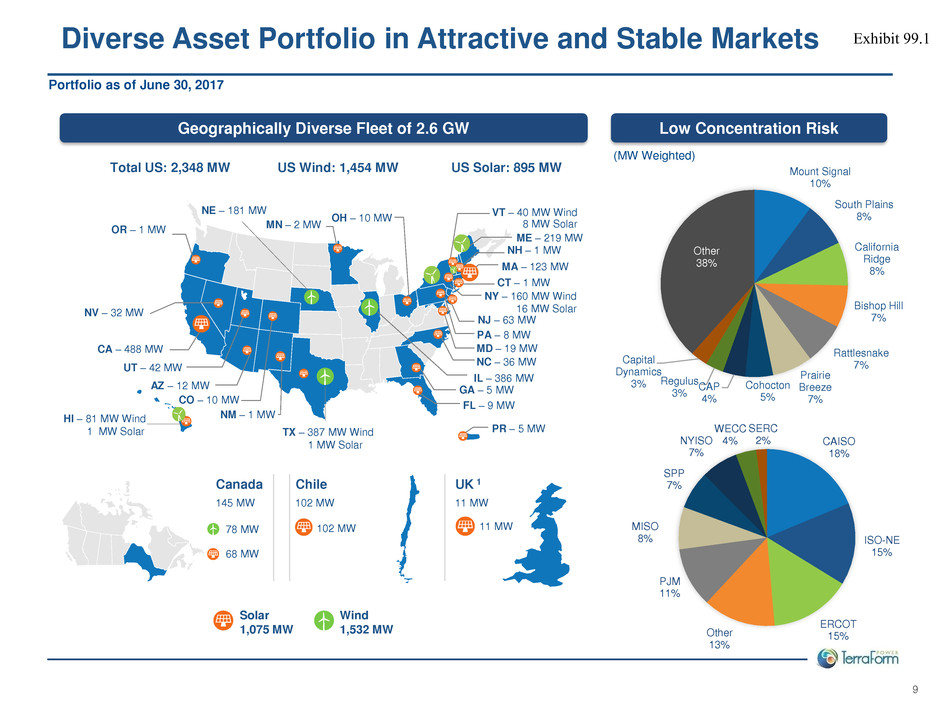
9 Low Concentration RiskGeographically Diverse Fleet of 2.6 GW Portfolio as of June 30, 2017 (MW Weighted) Wind 1,532 MW Solar 1,075 MW Total US: 2,348 MW US Wind: 1,454 MW US Solar: 895 MW Canada 145 MW 78 MW 68 MW Chile 102 MW 102 MW UK 1 11 MW 11 MW OR – 1 MW MN – 2 MW NE – 181 MW NV – 32 MW UT – 42 MW CO – 10 MW CA – 488 MW TX – 387 MW Wind 1 MW Solar HI – 81 MW Wind 1 MW Solar OH – 10 MW ME – 219 MW NH – 1 MW VT – 40 MW Wind 8 MW Solar MA – 123 MW CT – 1 MW NY – 160 MW Wind 16 MW Solar NJ – 63 MW PA – 8 MW MD – 19 MW NC – 36 MW IL – 386 MW GA – 5 MW FL – 9 MW PR – 5 MW NM – 1 MW AZ – 12 MW Diverse Asset Portfolio in Attractive and Stable Markets CAISO 18% ISO-NE 15% ERCOT 15%Other 13% PJM 11% MISO 8% SPP 7% NYISO 7% WECC 4% SERC 2% Mount Signal 10% South Plains 8% California Ridge 8% Bishop Hill 7% Rattlesnake 7% Prairie Breeze 7% Cohocton 5% CAP 4% Regulus 3% Capital Dynamics 3% Other 38% Exhibit 99.1

10 Definitions: Adjusted Revenue, Adjusted EBITDA and Cash Available For Distribution (CAFD) Reconciliation of Operating Revenues, Net to Adjusted Revenue We define adjusted revenue as operating revenues, net, adjusted for non-cash items including unrealized gain/loss on derivatives, amortization of favorable and unfavorable rate revenue contracts, net and other non-cash revenue items. This measurement is not recognized in accordance with GAAP and should not be viewed as an alternative to GAAP measures of performance, including revenue. Please see the next to last slide of this presentation for additional disclosures on the usefulness of Adjusted Revenue as a supplementary non-GAAP measure and on its limitations. Reconciliation of Net Income (Loss) to Adjusted EBITDA We define adjusted EBITDA as net income (loss) plus depreciation, accretion and amortization, non-cash affiliate general and administrative costs, acquisition related expenses, interest expense, gains (losses) on interest rate swaps, foreign currency gains (losses), income tax (benefit) expense and stock compensation expense, and certain other non-cash charges, unusual or non-recurring items and other items that we believe are not representative of our core business or future operating performance. This measurement is not recognized in accordance with GAAP and should not be viewed as an alternative to GAAP measures of performance, including net income (loss). Please see the next to last slide of this presentation for additional disclosures on the usefulness of Adjusted EBITDA as a supplementary non-GAAP measure and on its limitations, Note: As of December 31, 2015, TerraForm Power changed its policy regarding restricted cash to characterize the following as restricted cash: (i) cash on deposit in collateral accounts, debt service reserve accounts, maintenance and other reserve accounts, and (ii) cash on deposit in operating accounts but subject to distribution restrictions due to debt defaults, or other causes. Previously, cash available for operating purposes, but subject to compliance procedures and lender approvals prior to distribution from project level accounts, was also considered restricted. This cash is now considered unrestricted but is designated as unavailable for immediate corporate purposes. The impact of the new accounting policy on full year reported or forecasted CAFD is immaterial. Reconciliation of Adjusted EBITDA to CAFD Effective December 31, 2015, we define “cash available for distribution” or “CAFD” as adjusted EBITDA of Terra LLC as adjusted for certain cash flow items that we associate with our operations. Cash available for distribution represents adjusted EBITDA (i) minus deposits into (or plus withdrawals from) restricted cash accounts required by project financing arrangements to the extent they decrease (or increase) cash provided by operating activities, (ii) minus cash distributions paid to non-controlling interests in our renewable energy facilities, if any, (iii) minus scheduled project-level and other debt service payments and repayments in accordance with the related borrowing arrangements, to the extent they are paid from operating cash flows during a period, (iv) minus non-expansionary capital expenditures, if any, to the extent they are paid from operating cash flows during a period, (v) plus or minus operating items as necessary to present the cash flows we deem representative of our core business operations, with the approval of the audit committee. CAFD Is not a measure of liquidity or profitability, is not recognized in accordance with GAAP and should not be viewed as an alterative to net income (loss), operating income, net cash provided by operating activities or any other measure determined in accordance with U.S. GAAP. Please see the next to last slide of this presentation for additional disclosures on the usefulness of CAFD as a supplementary non-GAAP measure and on its limitations. Exhibit 99.1
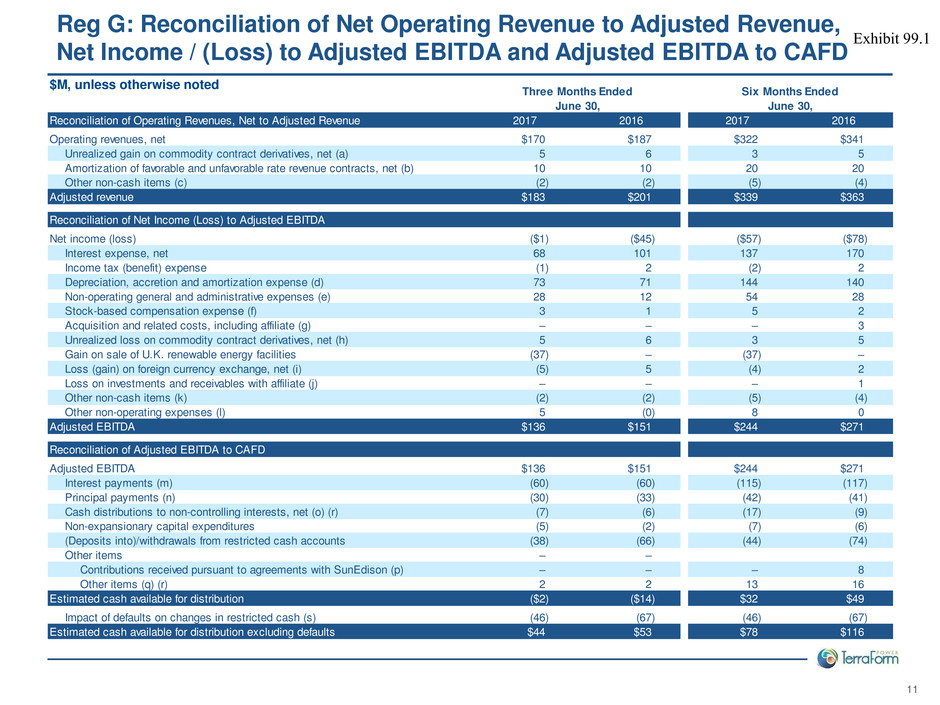
11 Reg G: Reconciliation of Net Operating Revenue to Adjusted Revenue, Net Income / (Loss) to Adjusted EBITDA and Adjusted EBITDA to CAFD $M, unless otherwise noted Three Months Ended June 30, Six Months Ended June 30, Reconciliation of Operating Revenues, Net to Adjusted Revenue 2017 2016 2017 2016 Operating revenues, net $170 $187 $322 $341 Unrealized gain on commodity contract derivatives, net (a) 5 6 3 5 Amortization of favorable and unfavorable rate revenue contracts, net (b) 10 10 20 20 Other non-cash items (c) (2) (2) (5) (4) Adjusted revenue $183 $201 $339 $363 Reconciliation of Net Income (Loss) to Adjusted EBITDA Net income (loss) ($1) ($45) ($57) ($78) Interest expense, net 68 101 137 170 Income tax (benefit) expense (1) 2 (2) 2 Depreciation, accretion and amortization expense (d) 73 71 144 140 Non-operating general and administrative expenses (e) 28 12 54 28 Stock-based compensation expense (f) 3 1 5 2 Acquisition and related costs, including affiliate (g) – – – 3 Unrealized loss on commodity contract derivatives, net (h) 5 6 3 5 Gain on sale of U.K. renewable energy facilities (37) – (37) – Loss (gain) on foreign currency exchange, net (i) (5) 5 (4) 2 Loss on investments and receivables with affiliate (j) – – – 1 Other non-cash items (k) (2) (2) (5) (4) Other non-operating expenses (l) 5 (0) 8 0 Adjusted EBITDA $136 $151 $244 $271 Reconciliation of Adjusted EBITDA to CAFD Adjusted EBITDA $136 $151 $244 $271 Interest payments (m) (60) (60) (115) (117) Principal payments (n) (30) (33) (42) (41) Cash distributions to non-controlling interests, net (o) (r) (7) (6) (17) (9) Non-expansionary capital expenditures (5) (2) (7) (6) (Deposits into)/withdrawals from restricted cash accounts (38) (66) (44) (74) Other items – – Contributions received pursuant to agreements with SunEdison (p) – – – 8 Other items (q) (r) 2 2 13 16 Estimated cash available for distribution ($2) ($14) $32 $49 Impact of defaults on changes in restricted cash (s) (46) (67) (46) (67) Estimated cash available for distribution excluding defaults $44 $53 $78 $116 Exhibit 99.1
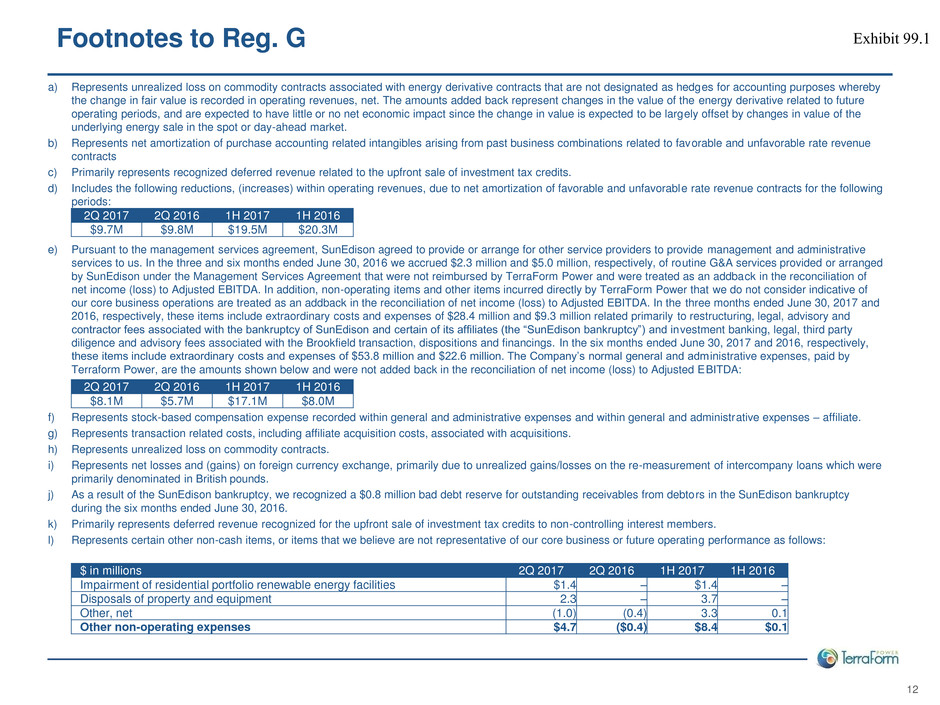
12 Footnotes to Reg. G a) Represents unrealized loss on commodity contracts associated with energy derivative contracts that are not designated as hedges for accounting purposes whereby the change in fair value is recorded in operating revenues, net. The amounts added back represent changes in the value of the energy derivative related to future operating periods, and are expected to have little or no net economic impact since the change in value is expected to be largely offset by changes in value of the underlying energy sale in the spot or day-ahead market. b) Represents net amortization of purchase accounting related intangibles arising from past business combinations related to favorable and unfavorable rate revenue contracts c) Primarily represents recognized deferred revenue related to the upfront sale of investment tax credits. d) Includes the following reductions, (increases) within operating revenues, due to net amortization of favorable and unfavorable rate revenue contracts for the following periods: e) Pursuant to the management services agreement, SunEdison agreed to provide or arrange for other service providers to provide management and administrative services to us. In the three and six months ended June 30, 2016 we accrued $2.3 million and $5.0 million, respectively, of routine G&A services provided or arranged by SunEdison under the Management Services Agreement that were not reimbursed by TerraForm Power and were treated as an addback in the reconciliation of net income (loss) to Adjusted EBITDA. In addition, non-operating items and other items incurred directly by TerraForm Power that we do not consider indicative of our core business operations are treated as an addback in the reconciliation of net income (loss) to Adjusted EBITDA. In the three months ended June 30, 2017 and 2016, respectively, these items include extraordinary costs and expenses of $28.4 million and $9.3 million related primarily to restructuring, legal, advisory and contractor fees associated with the bankruptcy of SunEdison and certain of its affiliates (the “SunEdison bankruptcy”) and investment banking, legal, third party diligence and advisory fees associated with the Brookfield transaction, dispositions and financings. In the six months ended June 30, 2017 and 2016, respectively, these items include extraordinary costs and expenses of $53.8 million and $22.6 million. The Company’s normal general and adm inistrative expenses, paid by Terraform Power, are the amounts shown below and were not added back in the reconciliation of net income (loss) to Adjusted EBITDA: f) Represents stock-based compensation expense recorded within general and administrative expenses and within general and administrative expenses – affiliate. g) Represents transaction related costs, including affiliate acquisition costs, associated with acquisitions. h) Represents unrealized loss on commodity contracts. i) Represents net losses and (gains) on foreign currency exchange, primarily due to unrealized gains/losses on the re-measurement of intercompany loans which were primarily denominated in British pounds. j) As a result of the SunEdison bankruptcy, we recognized a $0.8 million bad debt reserve for outstanding receivables from debtors in the SunEdison bankruptcy during the six months ended June 30, 2016. k) Primarily represents deferred revenue recognized for the upfront sale of investment tax credits to non-controlling interest members. l) Represents certain other non-cash items, or items that we believe are not representative of our core business or future operating performance as follows: 2Q 2017 2Q 2016 1H 2017 1H 2016 $9.7M $9.8M $19.5M $20.3M 2Q 2017 2Q 2016 1H 2017 1H 2016 $8.1M $5.7M $17.1M $8.0M $ in millions 2Q 2017 2Q 2016 1H 2017 1H 2016 Impairment of residential portfolio renewable energy facilities $1.4 – $1.4 – Disposals of property and equipment 2.3 – 3.7 – Other, net (1.0) (0.4) 3.3 0.1 Other non-operating expenses $4.7 ($0.4) $8.4 $0.1 Exhibit 99.1

13 Footnotes to Reg. G (continued) m) Represents project-level and other interest payments and interest income attributed to normal operations. The reconciliation from Interest expense, net as shown on the Consolidated Statement of Operations to Interest payments applicable to is as follows: n) Represents project-level and other principal debt payments to the extent paid from operating cash. The reconciliation from Principal payments on non- recourse long-term debt as shown on the Consolidated Statement of Cash Flows to Principal payments applicable to CAFD is as follows: o) Represents cash distributions paid to non-controlling interests in our renewable energy facilities. p) We received an equity contribution from SunEdison of $8.0 million pursuant to the Amended Interest Payment Agreement during the six months ended June 30, 2016. During the six months ended June 30, 2017, we received $7.0 million from SunEdison in satisfaction of outstanding claims made under EPC contracts. This contribution is considered non-operating and has therefore been excluded from CAFD. q) Represents other cash flows as determined by management to be representative of normal operations as follows: r) Tax equity “pay as you go” amounts received from non-controlling interests reclassified from Cash distributions to non-controlling interests, net to Other items for the six months ending June 30, 2016 to conform with current reporting methodology. s) Represents the accumulation of restricted cash as of June 30, 2017 due to the impact of SunEdison bankruptcy-triggered or related defaults for those defaults not resolved at September 22, 2017. $ in millions 2Q 2017 2Q 2016 1H 2017 1H 2016 Interest expense, net ($68.2) ($101.3) ($136.5) ($170.3) Amortization of deferred financing costs and debt discounts 5.4 6.4 10.0 15.2 Unrealized loss on U.K. interest rate swaps 1.7 29.9 2.4 29.9 Changes in accrued interest 1.4 7.4 3.7 6.9 Special interest on corporate bonds related to August 2016 waiver agreements 0.0 – 7.1 – Midco Portfolio Term Loan extension fee recorded to unamortized discount, net 0.0 – (2.4) – Other, net (0.4) (2.0) 0.3 0.8 Interest payments ($60.0) ($59.6) ($115.3) ($117.5) $ in millions 2Q 2017 2Q 2016 1H 2017 1H 2016 Principal payments on non-recourse long-term debt ($129.8) ($34.2) ($141.1) ($63.9) Blackhawk repayment of construction loan by SunEdison – – – 21.4 Midco Portfolio Term Loan prepayment 100.0 – 100.0 – Other, net (0.2) 1.4 (0.2) 1.7 Principal payments ($30.0) ($32.8) ($41.8) ($40.8) $ in millions 2Q 2017 2Q 2016 1H 2017 1H 2016 Major maintenance reserve releases / (additions) – – – $9.0 Rattlesnake ERCOT collateral release / (posting) – – – 4.5 Rattlesnake & Prairie Breeze I tax equity “pay as you go” amounts – – 6.9 4.6 Interconnection upgrade reimbursements 1.9 1.0 5.8 1.0 Other – 0.5 0.1 (2.7) Total Other items $1.9 $1.5 $12.8 $16.4 Exhibit 99.1

14 Adjusted Revenue, Adjusted EBITDA and CAFD are supplemental non-GAAP measures and their limitations are discussed below. Because of the limitations described below, we encourage you to review, and evaluate the basis for, each of the adjustments made to arrive at Adjusted Revenue, Adjusted EBITDA and CAFD. Adjusted Revenue We define Adjusted Revenue as Operating revenues, net, adjusted for non-cash items including unrealized gain/loss on derivatives, amortization of favorable and unfavorable rate revenue contracts, net and other non-cash revenue items. We disclose Adjusted Revenue as a supplemental non-GAAP measure because it presents the component of our operating revenue that relates to the energy production from our plants, and is, therefore, useful to investors and other stakeholders in evaluating the performance of our renewable energy assets and comparing that performance across periods in each case without regard to non-cash revenue items. In addition, Adjusted Revenue is used by our management for internal planning purposes, including for certain aspects of our consolidated operating budget. We believe Adjusted Revenue is useful as a planning tool because it allows our management to compare performance across periods on a consistent basis in order to more easily view and evaluate operating and performance trends and as a means of forecasting operating and financial performance and comparing actual performance to forecasted expectations. For these reasons, we also believe it is also useful for communicating with shareholders, bondholders and lenders and other stakeholders. Adjusted Revenue has certain limitations in that it does not reflect the impact of these non-cash items of revenue on our performance. This measurement is not recognized in accordance with GAAP and should not be viewed as an alternative to GAAP measures of performance, including Operating revenues, net. Adjusted EBITDA We disclose Adjusted EBITDA because we believe Adjusted EBITDA is useful to investors and other interested parties as a measure of financial and operating performance and debt service capabilities. We believe Adjusted EBITDA provides an additional tool to investors and securities analysts to compare our performance across periods and among us and our peer companies without regard to interest expense, taxes and depreciation and amortization. In addition, Adjusted EBITDA is also used by our management for internal planning purposes, including for certain aspects of our consolidated operating budget. We believe Adjusted EBITDA is useful as a planning tool because it allows our management to compare performance across periods on a consistent basis in order to more easily view and evaluate operating and performance trends and as a means of forecasting operating and financial performance and comparing actual performance to forecasted expectations. For these reasons, we also believe it is also useful for communicating with shareholders, bondholders and lenders and other stakeholders. Because of the limitations described below, however, we encourage you to review, and evaluate the basis for, each of the adjustments made to arrive at Adjusted EBITDA. Adjusted EBITDA is a supplemental non-GAAP financial measure. Our definitions and calculations of these items may not necessarily be the same as those used by other companies. Adjusted EBITDA is not a measure of liquidity or profitability and should not be considered as an alternative to net income, operating income, net cash provided by operating activities or any other measure determined in accordance with U.S. GAAP. Moreover, Adjusted EBITDA has certain limitations and should not be considered in isolation. Some of these limitations are: (i) Adjusted EBITDA does not reflect cash expenditures or future requirements for capital expenditures or contractual liabilities or future working capital needs, (ii) Adjusted EBITDA does not reflect the significant interest expenses that we expect to incur or any income tax payments that we may incur, and (iii) Adjusted EBITDA does not reflect depreciation and amortization and, although these charges are non-cash, the assets to which they relate may need to be replaced in the future, and Adjusted EBITDA does not take into account any cash expenditures required to replace those assets. Adjusted EBITDA also includes, among other things, adjustments for goodwill impairment charges, gains and losses on derivatives and foreign currency swaps, acquisition related costs and items we believe are infrequent, unusual or non-recurring, including adjustments for general and administrative expenses we have incurred as a result of the bankruptcy of SunEdison, Inc. and certain of its subsidiaries (the “SunEdison Bankruptcy”). These adjustments for infrequent, unusual or non-recurring items and items that we do not believe are representative of our core business involve the application of management judgment, and the presentation of Adjusted EBITDA should not be construed to infer that our future results will be unaffected by infrequent, non-operating, unusual or non-recurring items. Cash Available for Distribution We disclose CAFD because we believe cash available for distribution is useful to investors in evaluating our operating performance and because securities analysts and other stakeholders analyze CAFD as a measure of our financial and operating performance and our ability to pay dividends. In addition, cash available for distribution is used by our management team for internal planning purposes and for evaluating the attractiveness of investments and acquisitions. Because of the limitations described below, however, we encourage you to review, and evaluate the basis for, each of the adjustments made to calculate CAFD. CAFD is a supplemental non-GAAP financial measure. Our definitions and calculations of CAFD may not necessarily be the same as those used by other companies. CAFD is not a measure of liquidity or profitability, nor is it indicative of the funds needed by us to operate our business. It should not be considered as an alternative to net income (loss), operating income, net cash provided by operating activities or any other performance or liquidity measure determined in accordance with U.S. GAAP. CAFD has certain limitations and should not be considered in isolation. Some of these limitations are: (i) CAFD includes all of the adjustments and exclusions made to Adjusted EBITDA described above, including, but not limited to, not reflecting depreciation and amortization, and does not capture the level of capital expenditures required to maintain our assets and excludes certain other cash flow items that are not representative of our core business operations. These adjustments for items that we do not believe are representative of our core business involve the application of management judgment, and the presentation of CAFD should not be construed to infer that our future results will be unaffected by infrequent, non-operating, unusual or non-recurring items. Footnotes to Reg. G (continued) Exhibit 99.1
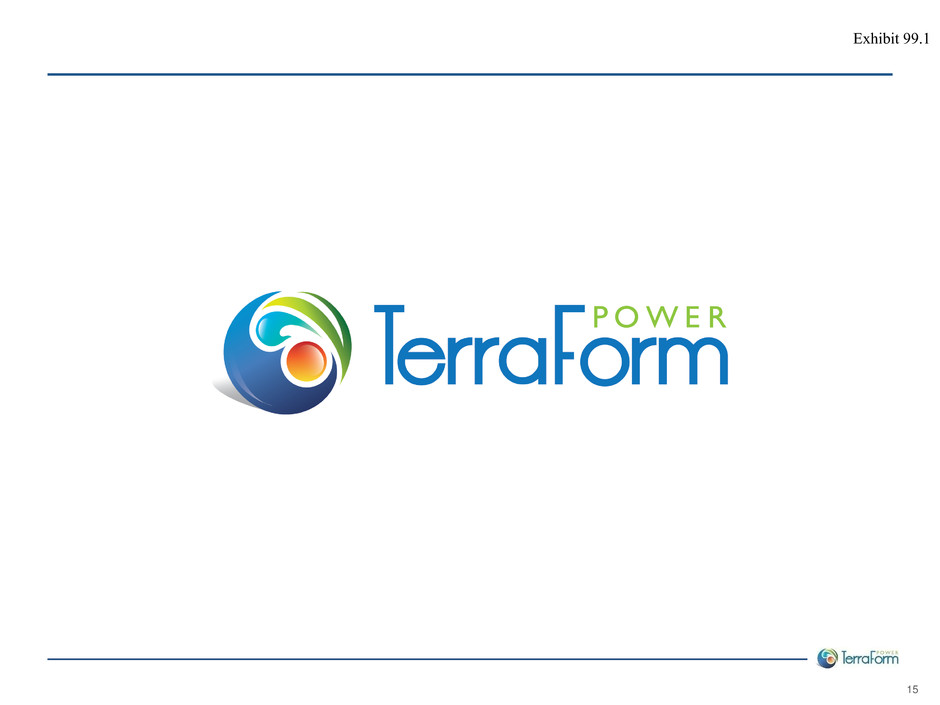
15 Exhibit 99.1